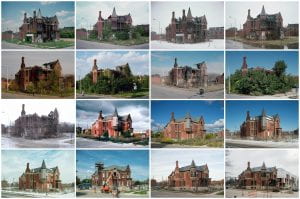
Former Ransom Gillis House in Detroit’s Brush Park neighborhood (© Camilo José Vergara)
Black families who managed to buy houses and hold onto them through the decades of disinvestment in the urban crisis finally saw a significant rise in land values in some neighborhoods in the 2000s. Unfortunately, this rise coincided with the rise of a system of predatory lending by now-unregulated mortgage banks. In an ironic reversal of redlining, some black neighborhoods in Detroit were now targeted for mortgage lending. But mortgages (and, more usually, refinancing) were of the “sub-prime” variety, that is with interest rates far above the prime rate for favored borrowers. Families that had finally paid off their mortgages over decades were especially targeted for refinancing, as high-pressure salesman dangled immediate cash in return for new mortgage loans that supposedly could be repaid through the continued rise in home prices. But when these home prices collapsed in the “Great Recession” of 2008, these families wound up losing their homes through foreclosure. Detailed mapping will enable visitors to see the scale of the foreclosure crisis and to relate predatory lending to the specific neighborhoods most affected.
Bringing the exhibit up to the present is controversial, but it is the only intellectually honest way to understand Detroit’s decades-long “production of decline.” But again the exhibit will also emphasize the rise of movements resisting foreclosure and seeking a way out of racializing space that dominated the years of urban crisis.
This chapter is still under construction.
See story map in Chapter 1 for work sample of what this chapter could become.







